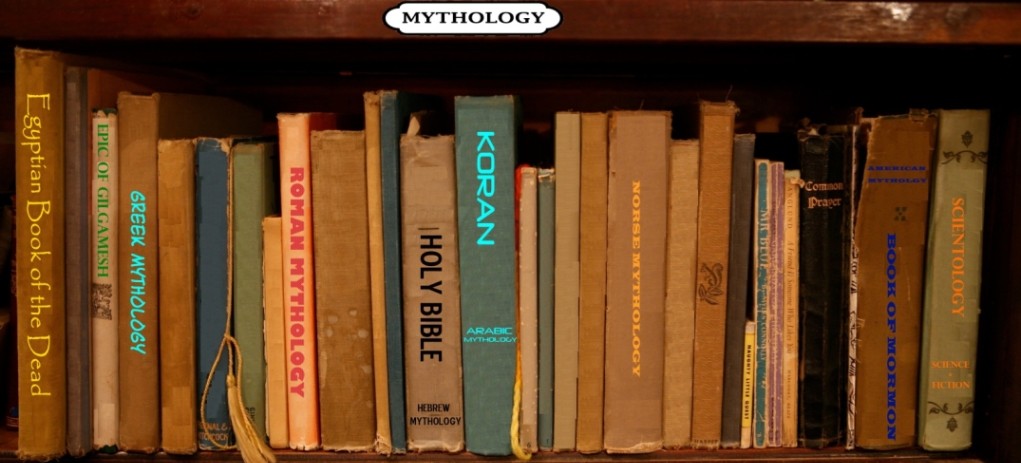
Modern day hunter-gatherers from Southern Africa.
An AEON article How Trance States Forged Human Society Through Transcendence explores the ideas of Robin Dunbar, a noted anthropologist and evolutionary psychologist with regards the primacy of religion in creating the human condition.
I think Dunbar is a typical “social-cognition-is everything-in-human evolution” commentator. Taking any sort of religion, mysticism, or transcendence, or trance dancing back to Archaic Homo of 200-400 thousand yrs ago is pure speculation with NO evidence for it, but that is the mainstream view and he echoes it, and they eat it up.
(Not surprisingly the author of the AEON article is a psychotherapist with degrees in Theology and ancient Greek philosophy–talk about being stuck in the past!-my bad)
I thought Dunbar was out-to-lunch when in his 2017 book on Human Evolution he claimed that tool-making in Paleo humans was “small beer” with regards our cognitive evolution-because other animals use tools. That statement is so ignorant its hard to respond to. But I did of course, in a short essay from 2018 describing my work-in-progress book on Cognitive Evolution :
Working title – “Tools, Concepts and Consciousness: Our Uniquely Human Cognitive Evolution”– TCC.
TCC will present a multi-disciplinary synthesis presenting a plausible story of the origins of human cognition which stands in direct contrast to the prevailing view that the origin of human cognitive skills was through our social and cultural behaviors: the Social Assumption, as expressed by the developmental and comparative psychologist Michael Tomasello’s: The Cultural Origins of Human Cognition (1999), and most recently reiterated by the anthropologist Robin Dunbar’s: Human Evolution: Our Brains and Behavior (2017).
Dunbar: “Much of the rest of the debate has hinged around instrumental behavior like tool-making and tool use. But in reality these are cognitively relatively small beer (emphasis mine)-even crows make and use tools, with a brain that is a fraction of the size of a chimpanzee”
The naivete’ expressed in that statement is quite astounding, especially for a trained and accomplished anthropologist/evolutionary psychologist. But it does reflect the common perspective of human cognitive abilities springing solely from our social calculus and cultural behaviors and the discounting of human tool manufacture, despite it being a cognitive driven ability that is wholly removed from animal tool use, not considering at all what it entails from a conceptual and consciousness standpoint. Dunbar is most certainly echoing the prevailing view in 2 respects: animal tool use and cognition isn’t that much different than ours, and – whatever unique cognition we do have is purely social and of a social origin. I will attempt to make a case in this book for quite the opposite: that the systematic, symmetric two handed competence tool manufacture of the Late Paleolithic is conceptually removed from mere animal tool use and is a significant if not deciding factor in human evolution from which our qualitatively advanced cognitive abilities emerged, largely spatial in nature and not deriving from social interaction.
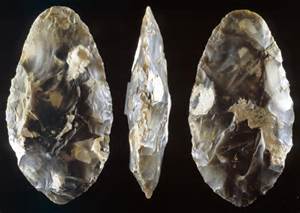
Can a crow make a symmetric Late Acheulian handaxe: a complex early tool from the last few hundred thousand years of our evolution, appearing millennia before cave art, bows and arrows, pyramids, sky scrapers, and smartphones? Can the crow, or chimp, stay on task and chip away for 30 minutes or more, employing hundreds of guided blows of a hammerstone on a haphazardly shaped stone core, these actions themselves comprised of 4 separate types, differing not only in handshape, force, angle, follow-through, and most importantly purpose, in an unscripted, contingent, series of sub-routine decisions, unique to every tool reduction sequence, all the while keeping the final shape in mind, including butt and point ends, L/R distinctions, symmetry, imagining a straight, even, edge…none of which exist nor are visible in the random starting shape of the core, employing such conceptual abilities as: framing and equalizing the spaces left over on the tool, understanding the transfer of force expressed in “flakes follow ridges”, maintaining an imaginary midline, utilizing a sense of relative time in the necessity of performing one sub-routine before another, but only after, another wholly different process? A crow bending a paper clip to retrieve a food morsel, however clever, is as distant cognitively, from symmetric handaxe manufacture as a child’s scribbling is from Shakespeare. Its not even writing yet-and the crow or chimps single too-use-minor-object-modification is not even simple tool manufacture. A screwdriver is already Shakespeare and the plethora of precision tools the modern human employs defies comparison.
Small beer indeed! Dunbar’s dismissive perspective is all-too typical of the current view that minimal alteration of a single tool for one proscribed use, by any given animal, is somehow equivalent to complex and varied human tool manufacture, being utterly ignorant of the uniquely evolved conceptual processes already employed by the Late Paleolithic hominids, and wholly disregarding the exploratory, constructive, and process discovery behaviors exclusive to the human animal, which motivate the developing infant/toddler to rediscover those evolved concepts anew with every childhood. The most clever of apes, or crows, can’t be taught to tie shoes, much less maintain a two-handed competence tool manufacturing task of varied sub-routines, recognize the spatial relationships of the closed class words, nor employ the embodied cognition and consciously guided deliberation, that mediates our unparalleled manipulo-spatial skills, which every child masters, millennia after they first evolved in the one bipedal primate: us.
Every 5 year-old wakes up knowing who they are, where they are, who their mommy is, and will soon include in their stream of consciousness, the time of day, day of the week, the season, and episodes of their life, unavoidably feeling the daily stress of getting things done. Their conscious experience will expand to contain all they know around them, centering on themselves as the protagonist in their singular, personal narrative. This stream of consciousness with a self, their self, oriented in space and time, imagining and accomplishing an infinite variety of tasks beyond early tool manufacture, I will propose, evolved along with and through the complex spatial, force, and object concepts listed above that first appeared as part of the Late Paleolithic hominid’s tool-making, cognitive repertoire. Our consciousness develops by increments in the minimally aware, but universally information seeking infant, by building concepts only the human animal employs, including that of the self.
The self is what the brain calls itself. Like our perceptions of the world filled with objects, beings, and events, beyond our- selves, our self- perception is not 100% veridical. We possess an evolved and constructed model, built up from the non-random fluctuations in physical magnitudes outside our own bodies, adding the visceral, proprio-receptive, mental, and visual input of our own actions and feelings to it: In short, building our selves from within and without. We are the actors on a stage in real time, from which we can also replay past episodes and imagine our actions in future scenes. This constructed model is our unique consciousness. The self is as real or unreal as any object. Whatever “ultimately” objects “really” are, or the self “really” is, our perceptions of the whole world with ourselves in that model (neither of which animals possess) – is pretty damn good: reliable, predictive, and broadly explanatory. Whether we are capable of understating the entire universe or all of existence, we are a long way from the crow and the chimp.
Neither they, nor a rock, a Rhododendron, your Rottweiler, nor a thermostat, can instantiate such a model with themselves in it. Without such concepts of objects, events, beings, and selves, along with the un-observable and spatially based abstract relations, there is no consciousness, no world. One evolved bipedal primate brain does this, solely because of the complex tool manufacture of the Late Paleolithic, from which we constructed our spatial concepts upon which all other abstract concepts, and our conscious model appear to depend. With this model, which includes our selves, we were then able to recognize other selves and create our sociocultural existence, which is secondary to the fundamental spatial concepts we employ in our conscious experience. Human culture as we know it, exploded only in the last 40,000 years, appearing well after all the concepts that enable it. Social interaction did not create our conceptual abilities, it is dependent upon them. Consciousness is not a gift from the gods, not a vibration of the universe with which we resonate. It is neither an inherent property of matter, nor an illusion. It is the product of our exploratory, constructive, conceptual, brain as is the late phenomenon of modern society and human culture.
Chimpanzees engage regularly in almost Machiavellian social interactions when not sleeping or feeding: grooming, holding grudges, dominating subordinates, forming alliances, challenging the alpha, and so on-and they never evolved language or the concepts our human languages map onto. Social cognition is one behavior that we do with our conceptual cognition. I suspect strongly that our evolutionary path is better described from the opposite perspective as Michael Tomasello and the mainstream view:
I suggest rather “The Cognitive Origin of Human Culture” instead of the other way around.
TCC will explore, from a plethora of existing multidisciplinary research, such questions as:
“When the hell did that evolve: such as re-representation of implicit animal cognition – for example, from the unconscious drive to survive all living creatures possess, to a conscious will to live and flourish…, from unconscious pattern recognition and problem-solving to conscious deliberation, scenario spinning, eureka moments, to spatial concepts (implicit, later explicit), and abstract concepts (most if not all mediated by spatial concepts), to inductive logic and hypothesis/test problem solving as in animal tracking, etc?”
(END of the TCC book precis, now back to the AEON article and its similar “social cognition is the driver of human cognition” presumptions with regards magico-religious activities in the Paleolithic)
The AEON article author reiterates Dunbar’s description of Paleolithic Cave Art and some earlier Portable Art as importantly containing examples of therianthropes: imaginary animal-human composite beings of unquestioned spiritual-religious import.
These 2 incredibly rare and questionable examples are both one-offs and don’t appear until 13-35,000 years ago-a few hundred thousand years removed from Archaic Homo times-so to use them to describe what hominins were thinking 300,000 years ago is more than a stretch. Even if they were unequivocal evidence of Paleolithic shamanism and early transcendent thinking-which they are not-they are separated from early Homo sapiens by hundreds of millennia. And it gets worse.
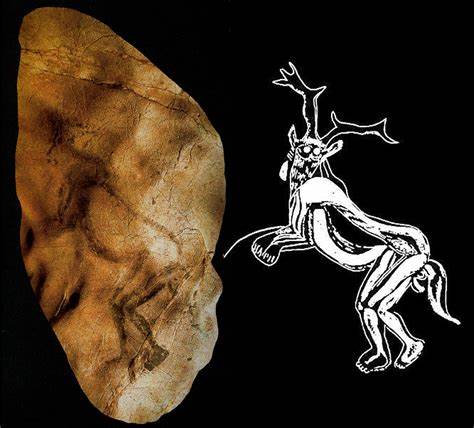
On the left is a photo of the original painting from Trois Freres cave in France dating to around 13,000 BC., on the right the Abbe Breuil’s oft-copied and somewhat enhanced drawing of the painting from the 1920’s.
This is the so-called “Sorcerer” cave painting which though claimed to depict a shaman-like animal-human, could well be a hunter in animal disguise – or just one example of the many vaguely drawn animal depictions which may not represent a human at all.
See for yourself-it is but one of thousands of rather indeterminate images from the Paleolithic which often are rather difficult to tell just what animal was being depicted. Drawing by the light of an animal-fat lamp on the rough surface of a cave wall in the pitch darkness of some often remote corner of a cave is quite a feat. The fact that they drew as many of the finely detailed and elaborate images as they did is impressive, to say the least. Much of the Paleolithic Cave Art images found in the hundreds of sites are somewhat cryptic and hard to interpret as often key details are left out or glossed over-leaving the viewer guessing just what the artist was trying to convey. The “Sorcerer” is no exception.
Breuil was a French Catholic priest who did extensive exploration and description of Paleolithic art sites in the early 20th century. You can well assume that his perspectives centered on the spiritual-he was not a disinterested, un-biased archaeological researcher, and though we all owe him for his early work, his magico-religious perspectives set the tone for the field from the beginning.
From the Wiki:
Henri Breuil asserted that the cave painting represented a shaman or magician — an interpretation which gives the image its name — and described the image he drew in these terms. Margaret Murray having seen the published drawing called Breuil’s image ‘the first depiction of a deity on Earth’, an idea which Breuil and others later adopted.
Breuil’s image has been commonly interpreted as a shaman performing a ritual to ensure good hunting.
His views held sway in the field for much of the 20th century, but they have since been largely superseded.
Anyone looking at the original painting can see how questionable the sorcerer/shaman interpretation is, yet when you google the Sorcerer you will regularly get Breuil’s imaginative sketch (not a photo of the actual painting), that adds the antlers, moves the tail from a more regular animal position, and adds detail to the feet and paws that are not clearly there in the cave painting. All this assumption upon assumption is has been uncritically accepted by many over the years, including the AEON author and Dunbar. Again, sure looks like but another example of modern magico-religious thinking coloring what we find in the Paleolithic.
Furthermore, not only is “hunting magic” assumed to be on the mind of the Paleolithic large mammal hunter, but even “a deity” as well as shamans and shamanistic rituals…
However, there is absolutely no evidence in any of the caves of repeated occupation-no evidence of ritual gathering or repeated visitation to any of the thousands of Cave Art locations—no footprints, no disturbed soil, nor dropped artifacts, no soot marks on walls or ceilings.
It is pitch dark in the caves and folks would need a lot of light to watch a shaman perform some ritual or cast a hunting magic spell. Last but not least so many of the images are in very inaccessible areas of the caves, hardly places to perform rituals or gatherings. The standard view that Paleo artists drew their impressive works of art such as those at Lascaux and Chauvet, so shamans could perform hunting magic rituals in front of them has no evidence to support it.
The whole shaman interpretation has no basis-other than that’s how many of the early researchers immediately saw Paleolithic Art. There are 10’s of thousands of images (mostly large hunted Ice Age mammals and local predators) and only this one painting and this one similar engraving shown below that could be construed as a shaman:
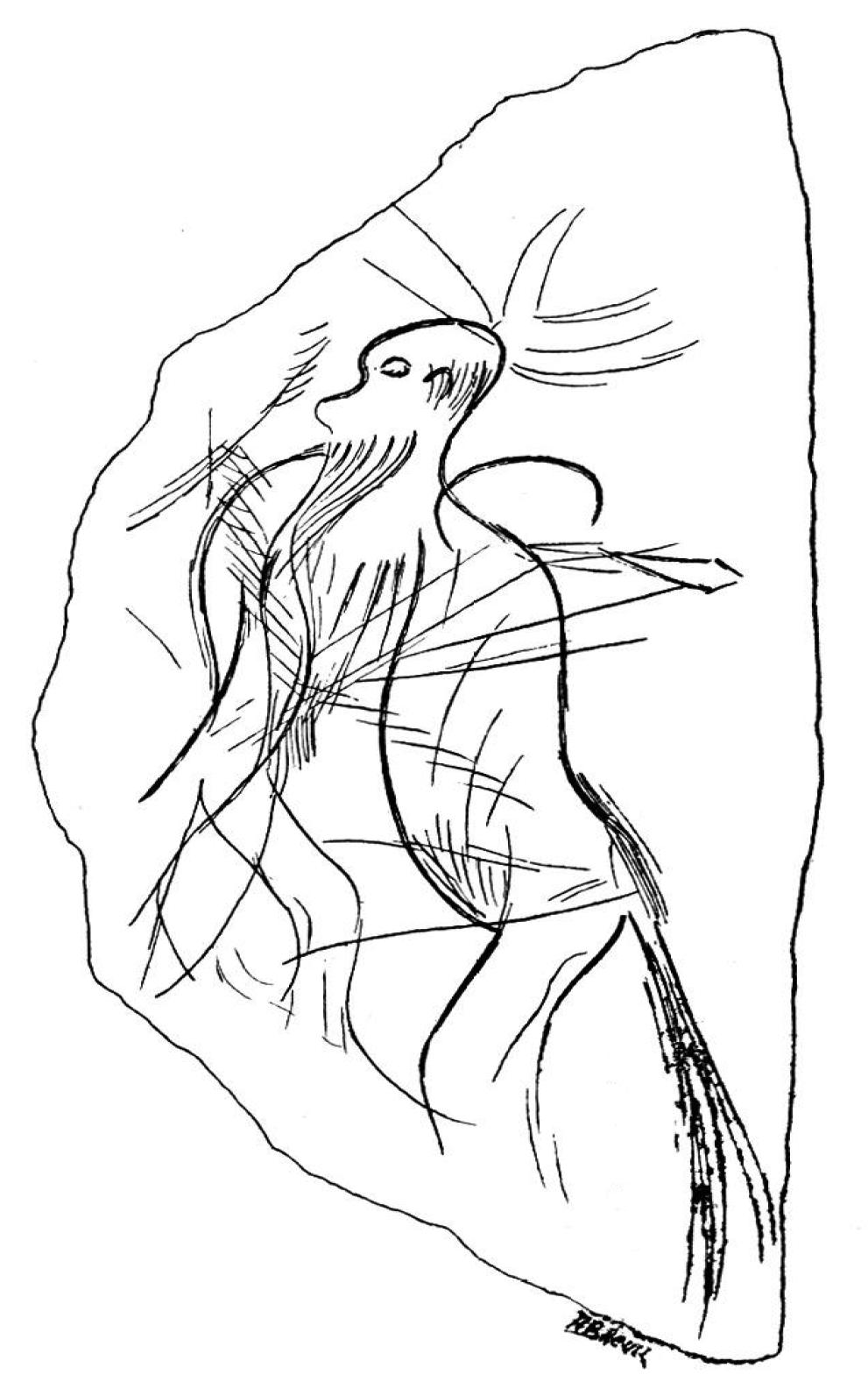
This could well be a simple un-detailed depiction of a hunter wearing animal disguise…which may have been a regular practice for Ice Age hunters- and this is at least as likely an interpretation, if not moreso than shamanism.
The image above is also a drawing of the original engraving – also by Abbe Breuil. The engraving hails from a cave in Lourdes, France-the Grotte de Espelugues, (dating unknown-15-30,000 BP most likely).
This is it: two images, both open to alternate interpretations, out of thousands of paintings and engravings spanning 30,000 years of Paleolithic Art, that are used to support the idea of shamanism. And no evidence of shamanistic ritual gathering anywhere in the hundreds of caves and rock-shelters. All we have is imaginative assumptions drawn from 2 enigmatic images…that’s it. As the WIKI noted-since Breuil’s early interpretation from the 1920’s, this assumption has largely been uncritically repeated been for nearly a century.
Interestingly, humans are rarely if ever depicted in Paleo Art-just the animals I mentioned above, and when they are-they are un-detailed stick figures: no faces, no portraits, no group scenes, no children or babies, or women. No dancing around the fire. Tribal and village scenes don’t appear until well into the Neolithic-most of it well after 10,000 BP, tens of thousands of years removed from Paleolithic times:
Here’s some examples of much later Neolithic tribal art and their typical depictions – wholly unlike Paleolithic Art in style and subject:
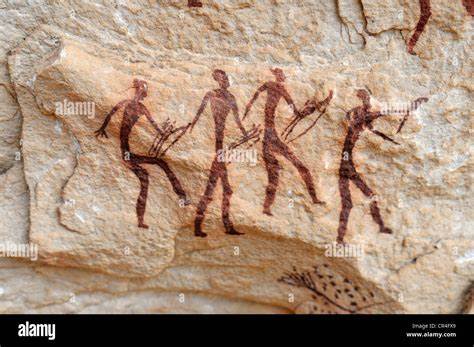
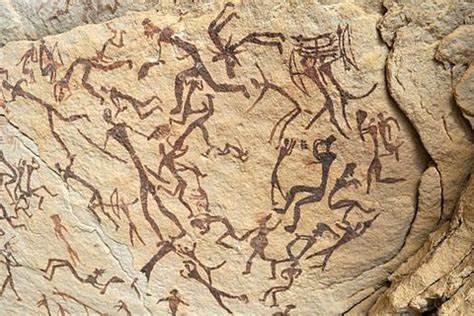
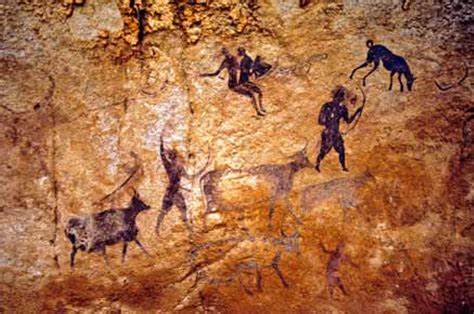
THERE ARE NO SUCH SCENES ANYWHERE IN PALEOLITHIC ART OF 12-40,000 BP.
Did the Paleo people think and act like Neolithic folks, much less like modern hunter-gatherers and tribal peoples?
From the Wiki on Shamanism:
“Shamanism is a religious practice that involves a practitioner (shaman) interacting with what they believe to be a spirit world through altered states of consciousness, such as trance. The goal of this is usually to direct spirits or spiritual energies into the physical world for the purpose of healing, divination, or to aid human beings in some other way.”
The earliest evidence we have of shamans-either written or archeological-is mostly from elaborate burials which appear much later in the Neolithic after 4,000 BC. One could easily question the assumption of shamanism in some of those burials as well. High status burials with elaborate grave goods have been around for millennia-but exactly what evidence differentiates a purely status burial from that of a shaman? Shamanism is reported to have begun with Neolithic Siberian peoples and was/is common among indigenous Americans, and in other locales such as Africa, but notably it is NOT universal. There is no evidence of shamanistic behavior in Greek and Roman cultures. Assuming shamanism and other magico-religious thinking-extrapolated mostly from historic and recent hunter-gatherers and tribal societies back to 20-40,000 BP Ice Age hunters or 200-400,000 BP early humans seems more than a bit of a stretch.
Below are some typical examples of Paleolithic Art depictions.
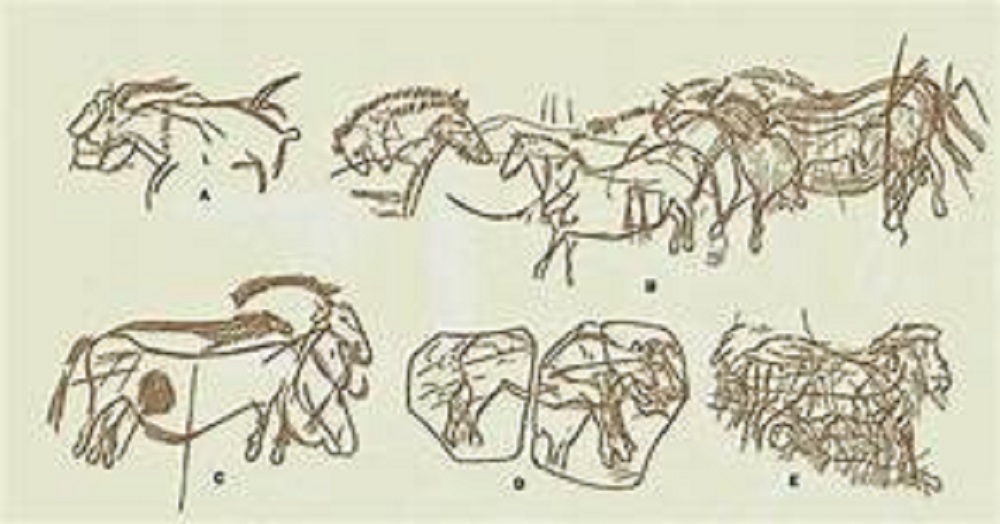
Look at the horses, ibex, and aurochs in first panel-drawn to varying degrees of accuracy in form and detail. Some parts are quite accurate, others out of proportion. A less-skilled artist, a skilled artist in a hurry, the artist made a mistake and left it as is, even tho they were trying to get it right…or just practice and not perfect with all the details.
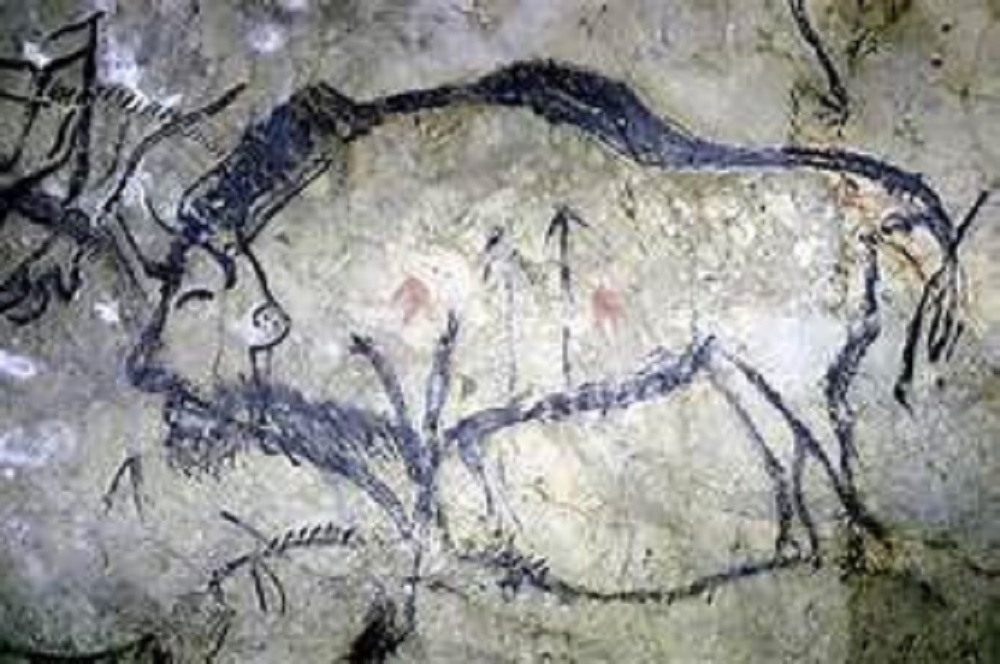
The bull in this picture is depicted with some detail to mane and rump and posture, but it fades away into a schematic rendering of the lower limbs-again not untypical. Interestingly, the face is drawn almost in double image with the nose depicted facing both forwards and backwards. It was common in this art to depict impossible renderings of posture to show detail that would not be seen in actual view. Was this a bad artist? Was this a clever depiction taking some license to describe detail? Does it show the duality of bullness as surmised in the subconscious Paleolithic mind?
Aha! But was it also a pre-figuring of the Janus myth-an early archetype bubbling up from the Paleo-collective unconscious?
(No, NOT a Freudian/Jungian slip on my part – I am fucking kidding, of course, but that IS the sort of “loose association” thinking that often occurs when trying to interpret these images)
Next, this simple horse sketch is just as typical as all the finely done, elaborate, and life-like animal portraits from sites like Lascaux and Chauvet that make it to all the coffee-table books on Paleo Art. The drawing is lacking in detail and inaccurate in form – maybe it depicts the latent pregnancy of all horses and is meant to exemplify the female mothering spirit-or maybe its just a fat male- a stallion cuckolded without genitals- or just a shitty image of a horse, drawn by a beginner AND THERE IS NO FUCKING DEEPER MEANING TO IT…

And lastly, check out the “weasel” from Niaux cave in France. It is basically a line drawing that seems to get the overall form of a weasel-type animal correct, yet notice the lack of detail in coat, facial features, or snout, and the lower limbs also just rough sketched and unfinished-no feet-again, so typical of much of Paleo art animal depictions. Did this mean weasels had no feet? Or was this a spiritual weasel essence that floated like Casper the Ghost?
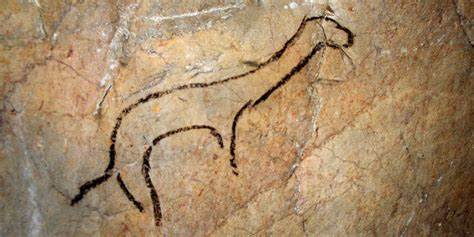
I am being purposely sarcastic here again, to demonstrate how easily we can make all sorts of assumptions from how a Paleo artist depicted an image-maybe this is all they wanted to convey-maybe they were a beginner and this is as good as it gets, maybe their fat-lamp was going out and they didn’t have the illumination left to fill-in the details- OR MAYBE the weasel was SACRED to them and they were always depicted drifting etherially into the nether-weasel-realm…oh, here we go again…
Look at the so-called “Sorcerer” again with this knowledge in mind.
The other commonly claimed therianthrope along with the “sorcerer”is the “lion-man” from 35-40,000 BC found in the Hohlenstein-Stadel cave in Germany.
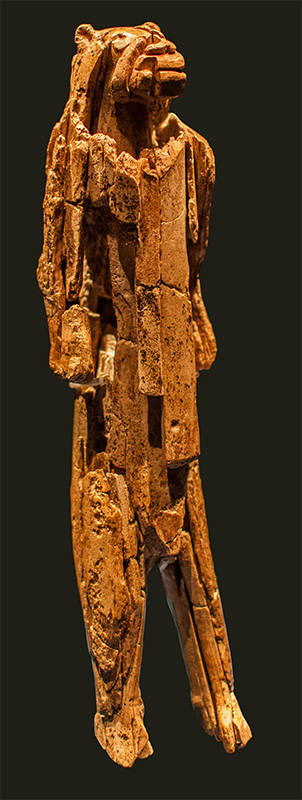
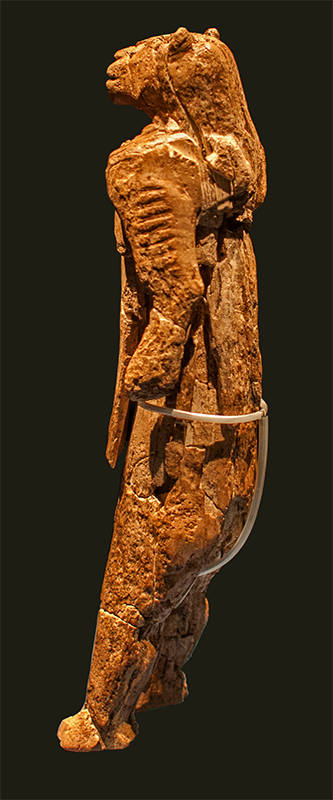
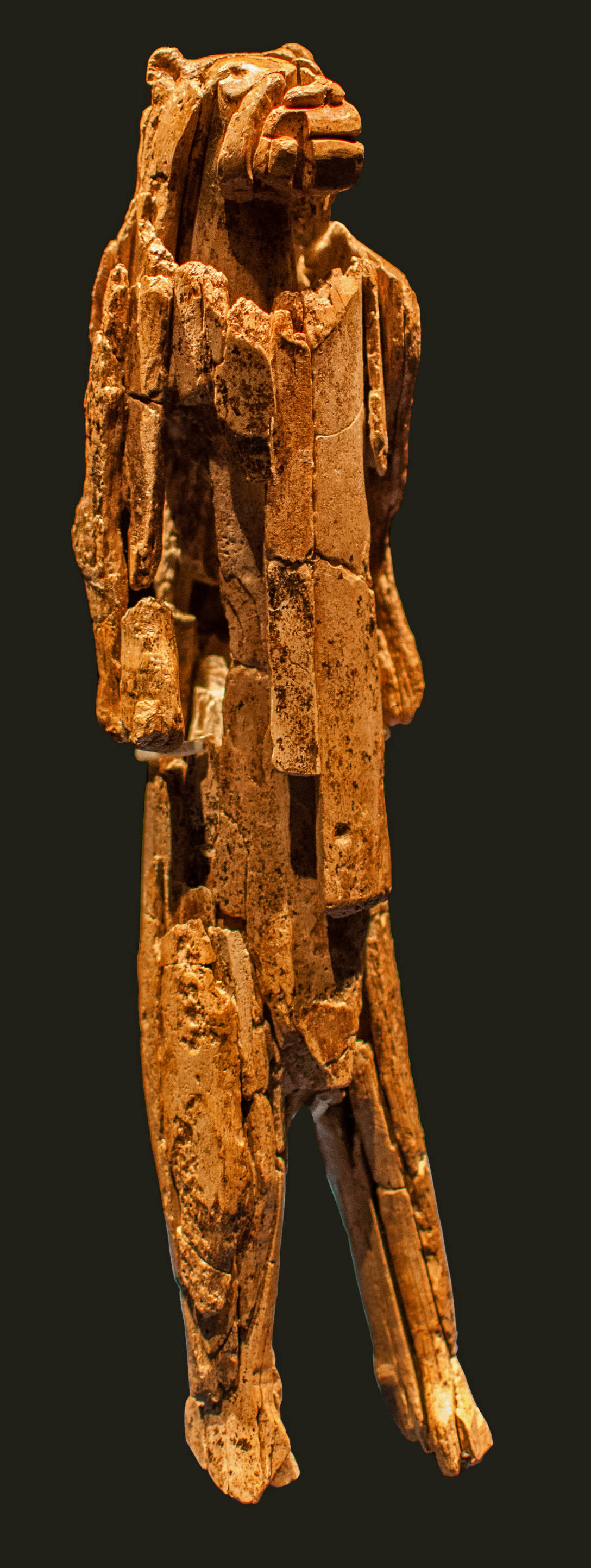
(Many thnx to Don Hitchcock and his phenomenal Don’s Maps website that is a published collection of detailed descriptions, maps and photos of HUNDREDS of Paleolithic sites! It is phenomenal!).
The “Lowenmensch” has also been interpreted as a woman due to ambiguous details on the belly and genital areas. And it could well be that the artist was depicting a cave bear-standing, as the snout is more reminiscent of the large flat lips of cave bears than the snout of a lion. Since it was found in 1937 the assumption has been “lion” and “man” – so that’s what it has been…but is it?
Is it a human-animal hybrid drawn for fun, artistically exploring the idea with no further import intended, or a lion drawn with a little artistic license, or a standing cave bear, (lions don’t stand like this, but bears do, and often-think of the performing circus bear), or a playful mix of animal and human features having no deeper significance to it-anymore than the imaginative doodlings of a high-schooler, or is it another shaman as many assume?
The majority of the figurines from this time are women-the famous “Venus figurines” with exaggerated buttocks, breasts, vaginas-little detail and most often-no faces or minimal facial features. And in the caves we find vulvae. There are lots of female anatomy depictions in the caves, paintings and engravings of vulvae with almost no complete figures and no faces. Here are some examples, again courtesy of Don’s Maps:
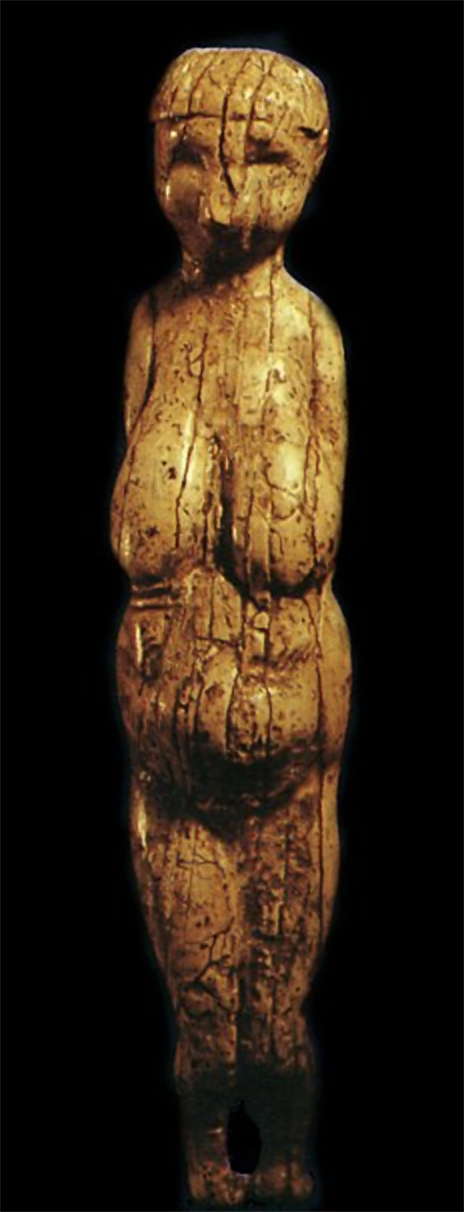
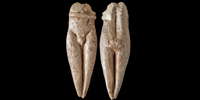
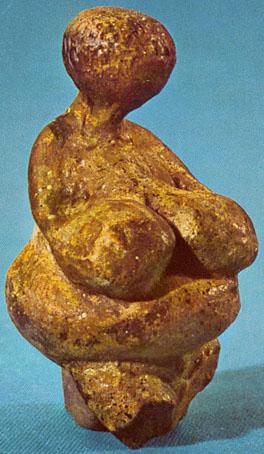
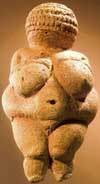

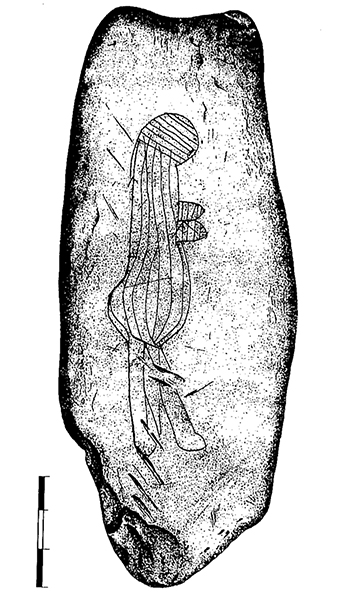
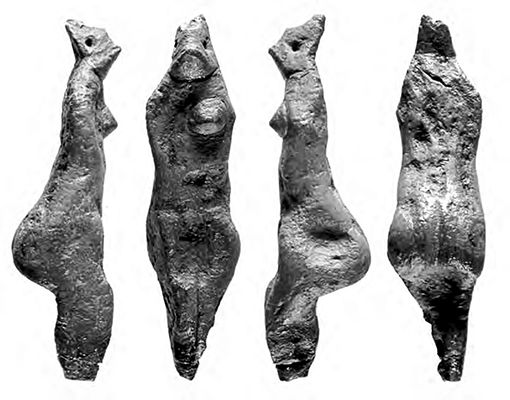
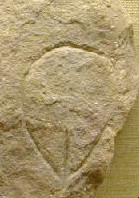
You wonder how the artists looked at women. Even though some of the Paleo artists could paint animal faces at times with such incredible precision and attention to detail-as in the Chauvet Lions:

…they never painted a beautiful woman’s face, or an endearing child, or a cuddly, cute baby- when some of them surely had the requisite skill to do it. It just wasn’t in their wheelhouse – across 30,000 years of such artwork. Do we want to assume they thought about women, love, family, children-just like us?
Much of our modern-day perspectives are not universal and may well be cultural behaviors that developed in different places and different times and may not go back 10, 40, or 400,000 years…such as shamans, and shamanistic rituals, trance dancing and the like.
Not until well after 10,000-12,000 BP and Neolithic tribal art do we see depictions of humans in group-tribal behaviors—which again, is so utterly different from the marvelous Late Paleo Cave Art.
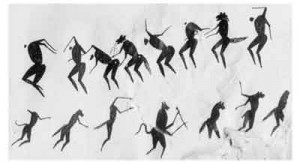
This is rock art from South Africa (dating unknown-assumed to be no earlier than Neolithic times for various reasons). It is said to depict San hunter-gatherers trance dancing in a typical shamanistic ritual that is still practiced even today. Nothing like this scene has ever been found from Paleolithic times.
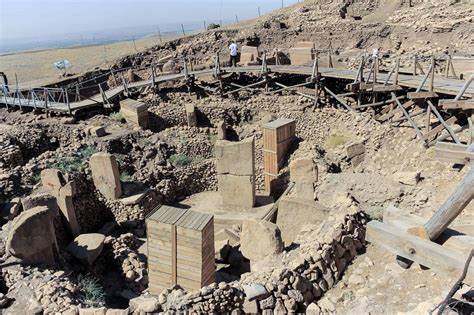
Gobekli Tepe
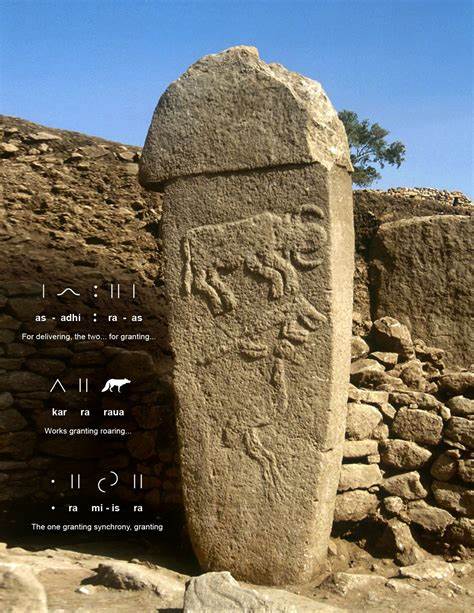
The AEON article notes that Dunbar describes the site of Gobekli Tepe as a religious-origin site, which is also the consensus view. It is one of the first large stone arrangements ever built, originally not thought of as a settlement, but a gathering place, well before Stonehenge and the Pyramids, and full of what looks like narrative artworks: stylized animal depictions, enigmatic geometric signs, etc. It could well be a temple of sorts and represent the earliest evidence of religion to date…, But it dates well after AFTER 10,000BP!!! Is it reasonable to extrapolate any ideas about the origins of religion from this site back another 10, 40, or 400 thousand years earlier?
The Late Paleolithic and earlier humans at 300-400,000 years ago may have been very different in their thinking than what we take as normal or as “natural” i.e. inborn, innate to all humans of any place and any time in history. Much of our modern world is comprised of ideas and perspectives of very recent cultural origin, ideas and perspectives that are not biological, not neurological, not universal.
For example, the Paleo hunters could track animals in a very logical method of hypothesis/test: assuming from minimal evidence in their tracks and spoor-where and when the animal was, was going and is now, checking that assumption out and trying another one when they didn’t locate the animal – yet they had no arithmetic, no science, no logic, no calculus etc., etc. Their brains were probably capable of modern thought, but those ideas ingrained in our modern culture hadn’t arose yet. Not for hundreds of thousands of years.

So when Dunbar and others assume with little to no evidence, as I have outlined above, anything like our sort of religiousness or any other modern cultural habit was there at 40,000 or 400,000 years ago-I am incredibly skeptical.
I feel much of the commentary on the Paleo and earlier hominins, with regards culture in general and religion in particular is just very similar special pleading and nothing else.
I think many current human evolution theorists are as enamored and locked into the “Social Assumption” as the be-all and end-all of explanation for the evolution of human behavior, as the 20th century social theorists harking back to Freud were of the “Nurture Assumption”-that everything a child or adult expressed in behavior and personality was to due to nurture-upbringing-environment-socialization-it was all “nurture” – and it was largely the parents fault!
Homosexuality, psychopathology, gender, autism, – you name it-your parents did it to you. You learned it from them and society/culture. Mostly it was your Mom’s fault, just ask Freud and his followers.
With an understanding of Behavioral Genetics beginning in the 70’s and modern neuroscience of the last 50 years, the Nurture Assumption has taken a back seat to more biological-nature explanations- not all nurture, and not at all just genes alone-but the complex interactions of genes and environment.
Methinks the “Social Assumption” especially regards religion and the origin of our unique conceptual cognition to be on just as “shaky ground”. (Nice spatial-movement metaphor there-to illustrate an abstract concept—that subject, metaphorical understanding and the use of spatial-force-movement concepts to explicate concepts such as space, time, kin, etc., should be the subject of a whole other essay-or two- down the road here someday).
In the meantime I think it prudent to take assumptions about Paleolithic shamanism with a grain of salt-or two.
(175)
